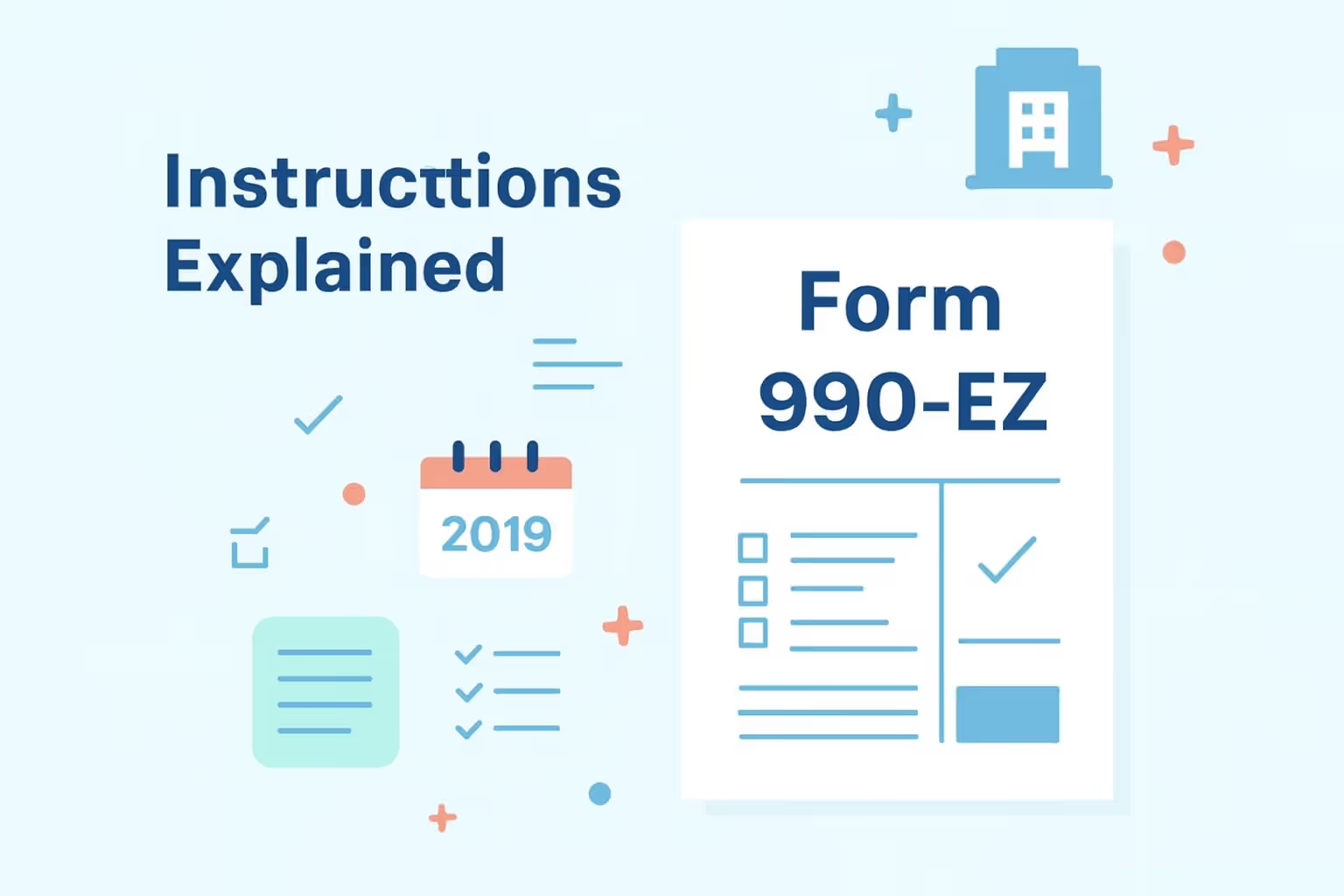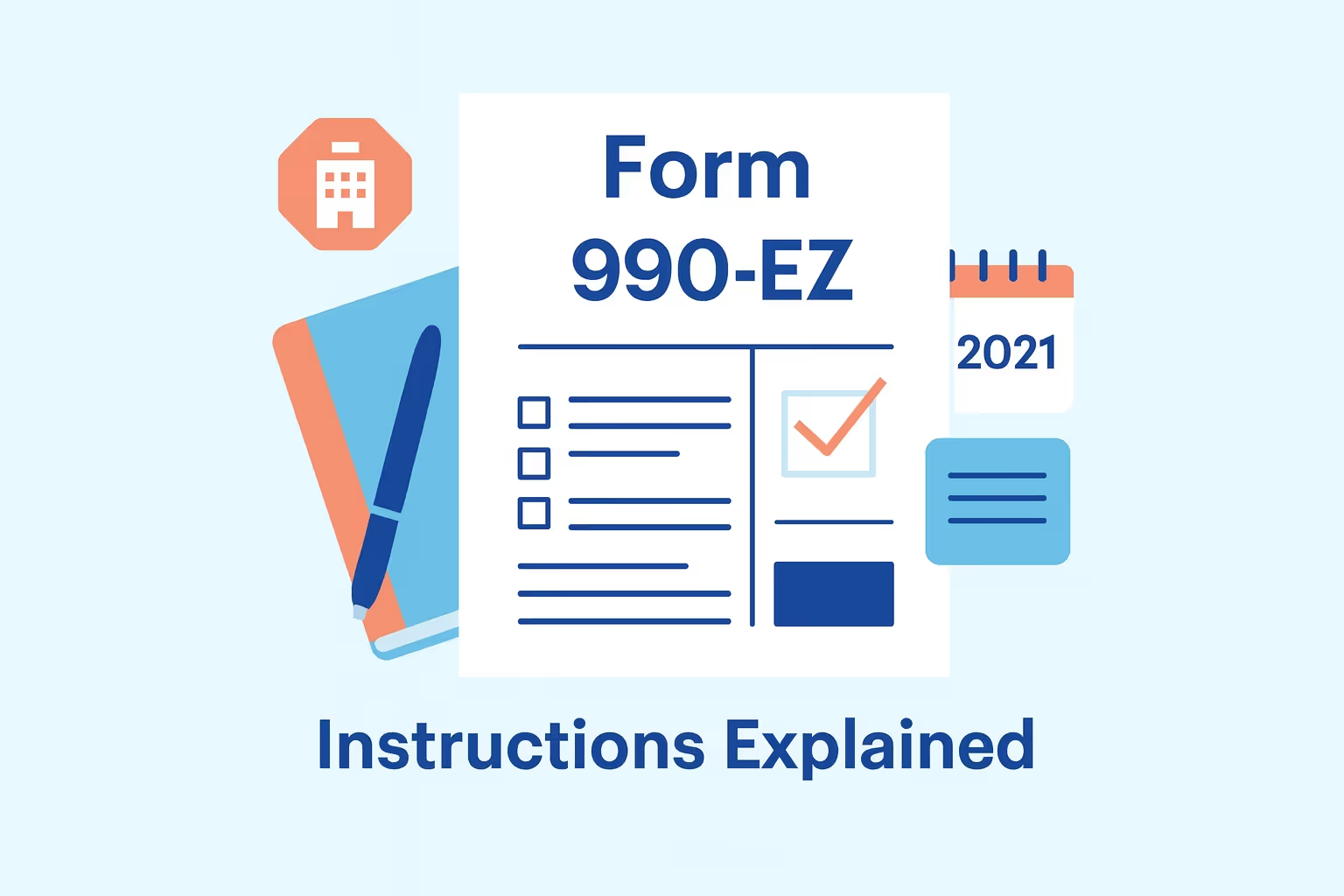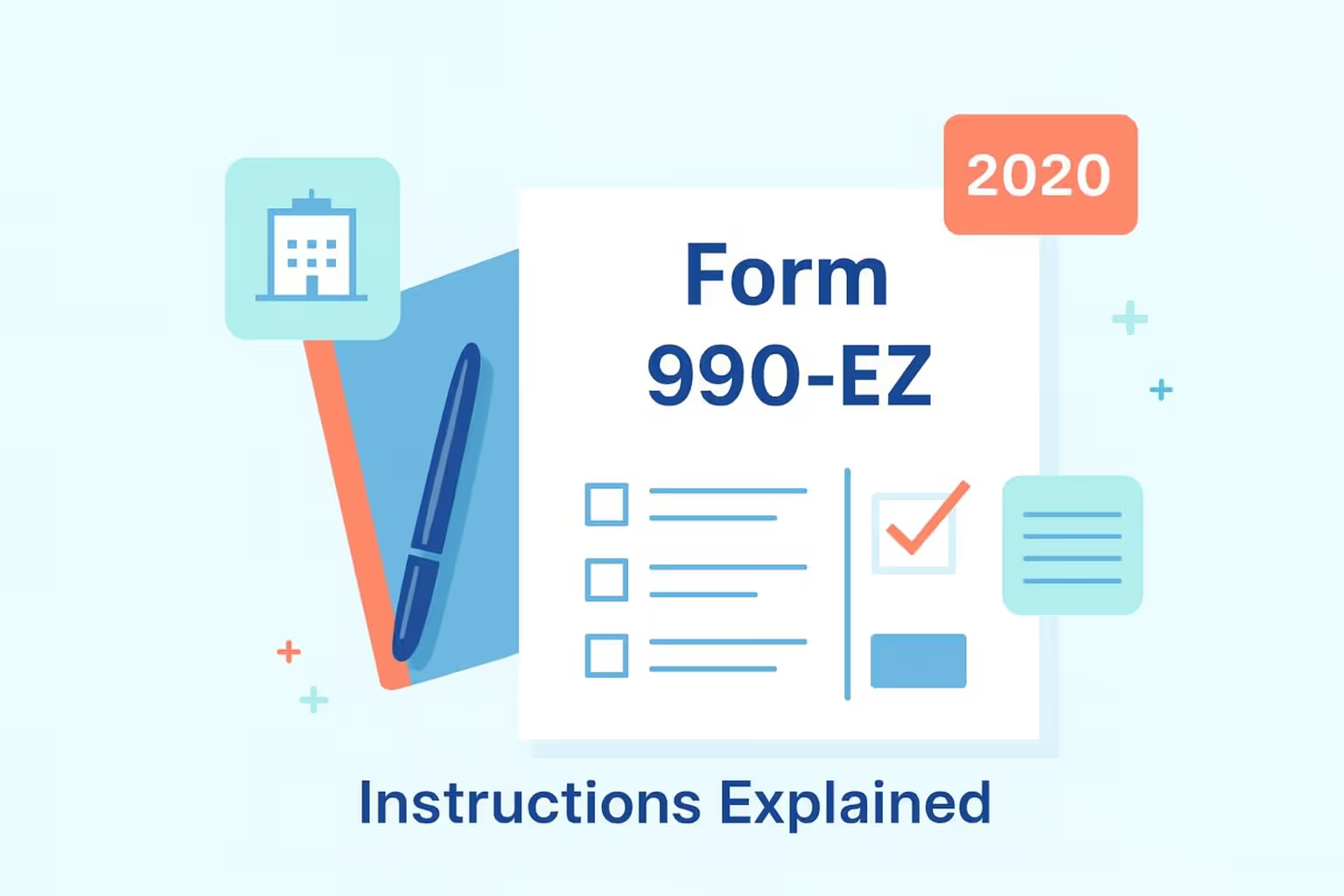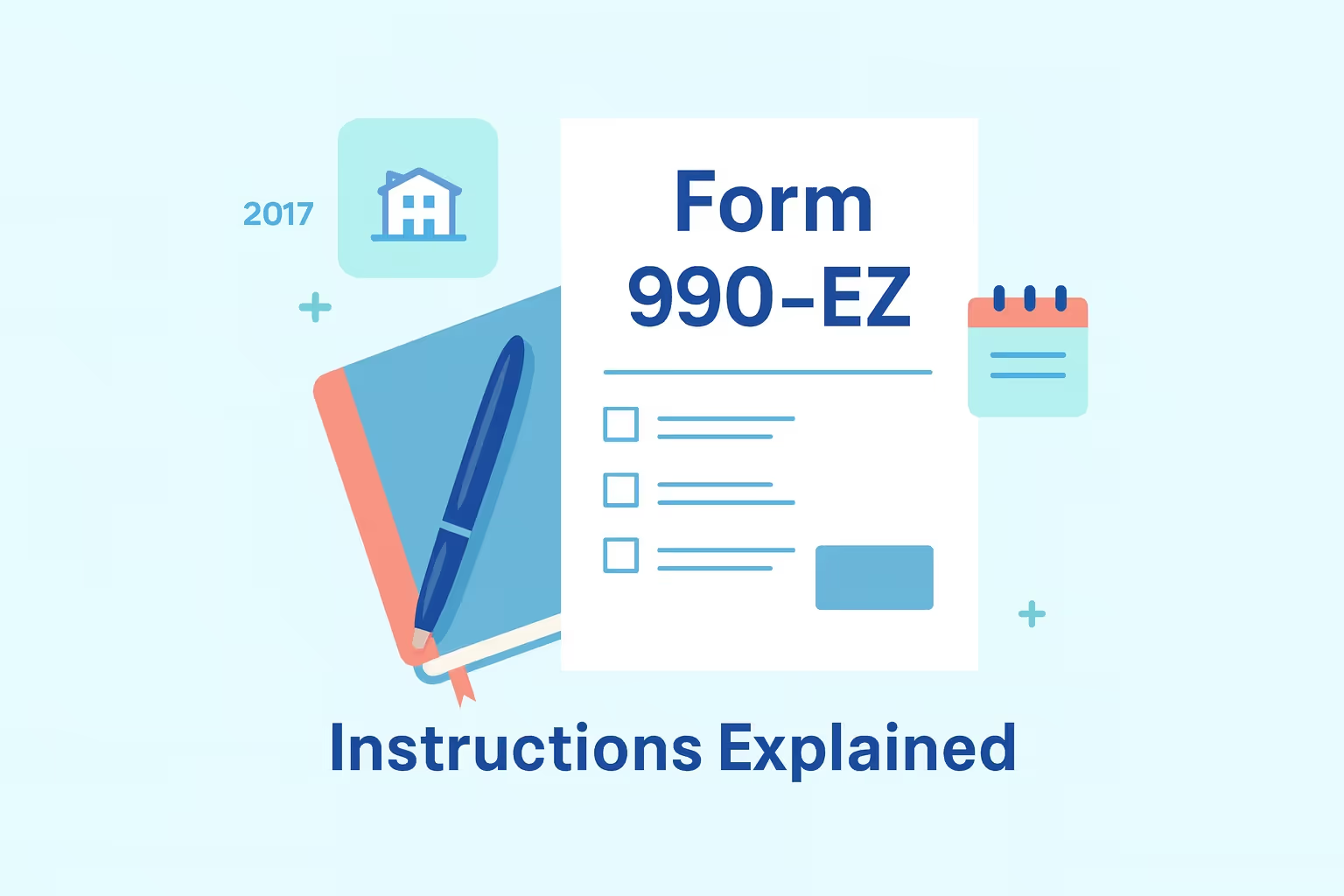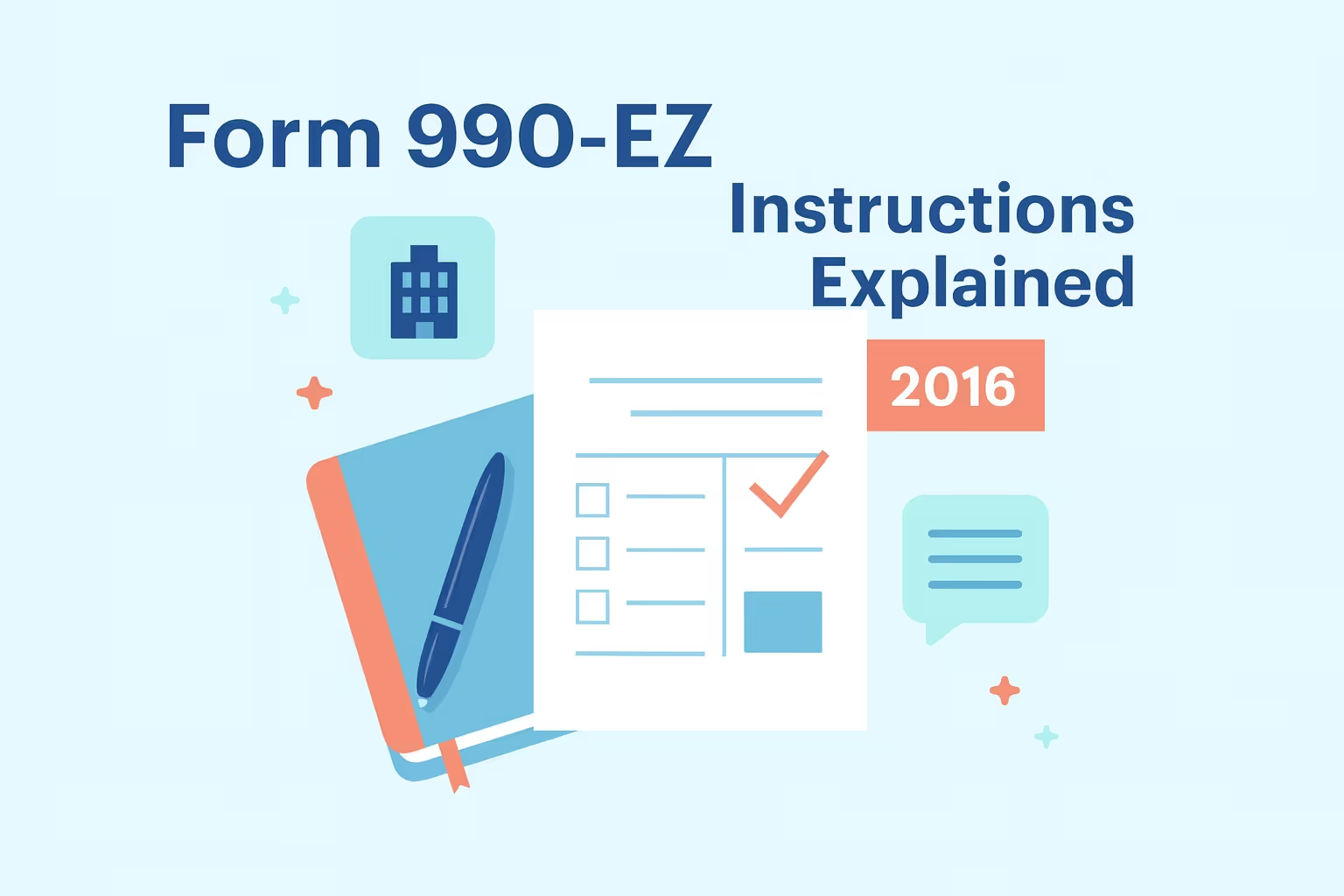Form 990-EZ 2010 Instructions: Tax-Exempt Filing Help
Form 990-EZ 2010 Instructions guide small organizations and nonprofit organizations in meeting their federal income tax reporting obligations. The form is designed explicitly for exempt organizations that are required to submit annual tax returns to disclose their revenue, donations, grants, and expenses. By filing accurately, nonprofits demonstrate accountability to donors, meet federal filing requirements, and present a clear record of their financial position. Transparent reporting also reinforces public confidence in how contributions are managed.
Every nonprofit organization with qualifying annual gross receipts is required to file a return that accurately reflects its mission and operations. Form 990-EZ streamlines this process for groups that meet specific financial thresholds, allowing smaller charities and religious entities to prepare their tax filings efficiently. Completing the return correctly enables the Internal Revenue Service to verify eligibility. It also helps organizations maintain good standing throughout the fiscal year. Clear documentation protects filers from additional fees caused by reporting errors or missing information.
According to the IRS Instructions for Form 990-EZ (2010), submitting the form on time supports the organization's continued exemption from federal income tax and demonstrates its commitment to transparency and accountability. Understanding these requirements helps nonprofits complete forms accurately, verify all data, and prepare for each filing deadline.
Understanding Tax-Exempt Status and Reporting Duties
Nonprofit organizations that hold tax-exempt status are required to meet specific annual filing obligations. The Internal Revenue Service requires these entities to file nonprofit tax returns to maintain compliance and ensure continued exemption from federal income tax. Accurate and transparent reporting of financial details ensures accountability to donors, contributors, and the public. It also verifies that funds, including grants and gifts, are used solely for charitable or religious purposes.
Purpose of Tax-Exempt Status
- Public Accountability: Filing annual tax returns demonstrates responsible stewardship of contributions, revenue, and donations. Each organization’s financial health becomes part of the public record, promoting trust among supporters.
- Government Oversight: Detailed tax filings enable agencies to monitor exempt organizations, ensuring compliance with Section 501(c) standards and eligibility for future exemptions.
- Mission Alignment: Reporting activities clarify how the organization fulfills its mission and manages resources effectively throughout the tax season.
Reporting Requirements
- Annual Disclosure: Each exempt organization must file a federal tax return reflecting its gross receipts, revenue, and expenses. This disclosure confirms the proper use of funds to support charitable work.
- Financial Documentation: Organizations should keep accurate records of grants, donations, and program expenditures to verify transparency and accountability. Complete data protects against errors that may lead to additional fees or filing delays.
- Eligible Entities: Exempt groups include charities, churches, private foundations, and other organizations recognized under Section 501(c). Each must prepare returns based on annual gross receipts and asset levels.
Maintaining Compliance
- Accuracy and Transparency: Each filing period enables nonprofits to demonstrate integrity in managing resources and fulfilling their federal income tax obligations.
- Status Verification: Entities can confirm current standing and review prior filings through the IRS Tax-Exempt Organization Search, which displays current records and historical data for registered filers.
- Recordkeeping Standards: Maintaining clear records throughout the fiscal year ensures timely submissions and reinforces trust with donors and government reviewers.
Consistent and accurate reporting enables tax-exempt organizations to maintain public confidence and ensure compliance across multiple reporting periods. By meeting annual disclosure requirements, nonprofits strengthen transparency, protect their exempt classification, and uphold the values central to their charitable mission.
Eligibility Rules and 2010 Filing Thresholds
Nonprofit organizations must confirm eligibility before preparing Form 990-EZ 2010. Understanding these requirements helps each filer maintain compliance with federal income tax laws and report accurate financial details. Organizations determine eligibility based on annual gross receipts, total assets, and classification under Section 501(c).
Who Can File Form 990-EZ
Organizations may file Form 990-EZ if they meet the IRS financial limits for small organizations. Eligible entities must have gross receipts under $200,000 and total assets below $500,000 at the end of the fiscal year. This simplified return enables nonprofits to disclose revenue, donations, and grants in a manner that reflects the organization’s financial position.
Filing the correct form enables nonprofits to fulfill their annual tax return obligations and enhance transparency with donors, trustees, and government agencies. Accurate reporting also supports accountability by demonstrating how contributions and resources are utilized to achieve the organization’s mission. Reviewing all data before filing ensures compliance and prevents issues related to missing or inconsistent information.
Who Must File the Full Form 990
Organizations with gross receipts exceeding $200,000 or assets exceeding $500,000 must submit the complete Form 990. Larger charities, private foundations, and other organization types with complex operations need this expanded format. The detailed report captures program accomplishments, officer compensation, and other key financial disclosures.
Specific exempt organizations are required to complete the full form, regardless of their size or status. These include hospitals, sponsoring agencies for donor-advised funds, and some religious entities with significant revenue or assets. Verifying thresholds and classification each fiscal year helps organizations file the correct return type confidently.
Optional Filers and Exclusions
Nonprofits with annual gross receipts of $50,000 or less may file the e-Postcard (Form 990-N) instead. This option provides a simplified way to maintain tax-exempt status and confirm operational activity. Churches, integrated auxiliaries, and certain government affiliates are generally excluded from filing but should verify eligibility regularly.
Evaluating annual data ensures that organizations submit tax filings that accurately reflect their financial position. By maintaining precise records, confirming thresholds, and selecting the proper form, each nonprofit can strengthen its compliance record and preserve long-term exemption.
Step-by-Step Guide to Completing Form 990-EZ
Preparing Form 990-EZ 2010 requires accurate data, organized records, and close attention to IRS filing standards. Each nonprofit organization must provide complete financial details that show accountability and compliance with federal income tax obligations. The steps below outline how small organizations can accurately file form versions, minimize errors, and maintain transparency throughout the process.
Step 1: Gather Financial Records and Supporting Data
Start with a complete set of financial records for the fiscal year. Collect accounting statements, receipts, donor lists, and bank reconciliations that verify gross receipts, revenue, donations, and grants. Confirm each figure with original financial records or receipts.
Well-organized data reduces inconsistencies and strengthens reporting accuracy. Each amount should align with internal ledgers and financial summaries. Maintaining consistent records builds trust with trustees, accountants, and government reviewers.
Step 2: Complete the Header Section
Include a header that identifies the organization for federal review, with its legal name, Employer Identification Number, physical address, and fiscal year dates. Confirm every entry matches IRS records to prevent delays.
- Initial Return: Select “Initial Return” if the organization is filing its first annual return.
- Final Return: Select “Final Return” if the entity has dissolved or closed operations.
- Amended Return: Select “Amended Return” if the organization is correcting or updating prior filings.
Accurate details ensure proper classification and smooth processing. Review all fields before moving forward to the financial sections.
Step 3: Record Revenue and Expenses in Part I
Part I summarizes the organization’s gross receipts, revenue, and expenses. Report all income, including contributions, membership dues, and investment returns. Record significant costs such as grants, salaries, and occupancy expenses.
- Use gross figures, not net totals.
- Cross-check entries with financial statements.
- Keep categories consistent with bookkeeping records.
Complete and consistent reporting enables reviewers to assess the organization’s financial health and alignment with its mission.
Step 4: Prepare the Balance Sheet in Part II
Part II outlines assets, liabilities, and net assets. Record beginning and ending balances for each column and confirm that the totals reconcile. Balanced figures prove sound accounting practices and support organizational credibility.
Step 5: Summarize Accomplishments in Part III
Describe key program service accomplishments linked to the organization’s charitable mission. Use precise language focused on measurable outcomes rather than subjective claims. Limit responses to the three most extensive programs by expense to ensure concise, relevant reporting.
Step 6: Identify Officers, Trustees, and Key Employees in Part IV
List all individuals who served during the fiscal year, including officers, trustees, and key employees. Provide names, titles, average weekly hours, and compensation amounts. Accurate reporting promotes transparency and governance compliance.
Step 7: Respond to Compliance Questions in Part V
Answer all operational questions thoroughly and provide the required explanations. Review each response carefully to ensure clarity and consistency. Affirmative answers often require supporting schedules or documentation to substantiate them.
Step 8: Attach Required Schedules and Authorize the Return
- Schedule A: Include Schedule A to confirm public charity status and support.
- Schedule O: Include Schedule O to provide narrative explanations.
Arrange documents in order, sign the form, and retain a copy for records. Follow these steps to ensure accurate filing, reinforce accountability, and preserve tax-exempt eligibility. Consistent documentation also supports future reviews and smooth annual reporting.
Filing Deadlines, Extensions, and Late Filing Consequences
Nonprofit organizations must meet strict deadlines when submitting Form 990-EZ 2010. Filing on time protects tax-exempt status and maintains compliance with federal income tax requirements. Every organization should understand its due date, available extension forms, and the effects of late submission.
The filing deadline depends on whether the organization uses a fiscal year or a calendar year. Returns are due on the 15th day of the fifth month after the close of the accounting period. For calendar year filers with a year-end date of December 31, the deadline is May 15, 2011. Fiscal year filers must calculate based on their year-end date to ensure timely delivery.
Meeting deadlines reinforces accountability with donors, trustees, and government agencies. It also helps small organizations avoid additional fees and safeguard their financial reputation. Filing on time demonstrates a commitment to transparency and reliable management.
Key Filing Considerations
- Calendar Year and Fiscal Year Deadlines: Each organization must verify its accounting cycle to calculate the correct due date. Accurate scheduling prevents missed deadlines and ensures compliance with annual reporting obligations.
- Holiday Adjustments: If a due date falls on a weekend or a legal holiday, the filing deadline is extended to the next business day. This rule applies to both electronic and paper submissions.
- Review Periods: Organizations should schedule internal reviews well in advance of submission to verify that all data, signatures, and attachments are complete. Allowing adequate preparation time reduces the risk of incomplete filings.
Extension Requests
Organizations that need additional time may request an automatic three-month extension using Form 8868. The application must be submitted on or before the original due date. This process enables nonprofits to finalize financial details, confirm data accuracy, and compile the required schedules.
Refer to IRS Form 8868 – Extension for Exempt Organization Returns, which outlines eligibility and submission requirements. Filing the extension form promptly helps organizations stay compliant and confirm acknowledgment of additional time.
Consequences of Late Filing
- Daily Fees: Small organizations may incur a $20 daily fee for each day the return is late. Larger organizations can face higher assessments based on their gross receipts.
- Incomplete Returns: Missing schedules or unanswered questions may cause the IRS to treat the return as late or incomplete.
- Loss of Tax-Exempt Status: Failing to file for three consecutive years results in the automatic revocation of tax-exempt status, requiring organizations to reapply for tax-exempt status.
Filing Form 990-EZ accurately and on time preserves compliance and builds confidence with regulatory agencies and stakeholders. Monitoring deadlines, requesting extensions when needed, and verifying data ensure a smooth reporting process for every filing period.
Electronic Filing vs. Paper Submission
Nonprofit organizations filing Form 990-EZ in 2010 can choose between electronic filing and paper submission, depending on their eligibility and the availability of their filing infrastructure. Understanding both methods ensures forms are completed accurately, schedules are attached, and the return reaches the Internal Revenue Service within the required timeframe. Selecting the correct process supports compliance and enhances the organization’s financial reporting efficiency.
Electronic filing is mandatory for specific exempt organizations that file a high number of returns or manage significant assets. Paper submission remains available for smaller entities that meet eligibility criteria. The table below compares the main differences between these two filing methods to help organizations select the most suitable approach.
- Electronic Filing (E-File)
- Eligibility and Requirements: Required for organizations filing 250+ returns annually or with total assets of $10 million or more
- Key Features: Uses IRS-authorized e-file providers and secure submission portals
- Advantages:
- Faster confirmation of receipt
- Reduced errors through system validation
- Considerations:
- Requires reliable internet access
- Needs compatible software and trained personnel
- Paper Submission
- Eligibility and Requirements: Available for small organizations with fewer returns and lower asset values
- Key Features: Manual preparation, printing, and mailing to the IRS
- Advantages:
- Allows handwritten notes
- Accepts original signatures
- Considerations:
- Longer processing times
- Possible mail delays
Each filing method involves distinct responsibilities. Electronic filers must ensure the accuracy of their software and the integrity of their data. Paper filers should prepare complete packages with all necessary attachments. Organizations must thoroughly review all information before submitting it through either process.
Small organizations may opt for paper submission for simplicity, while larger entities utilize electronic systems that support data validation and processing. Both options demand strict attention to details such as signatures, form order, and schedule completion.
Selecting the correct filing method ensures accuracy, timeliness, and compliance with IRS requirements. By verifying eligibility, preparing documentation carefully, and adhering to submission protocols, organizations ensure compliance and demonstrate a strong commitment to transparent financial reporting.
Required Schedules and Attachments
Form 990-EZ 2010 requires several supporting schedules and attachments to complete a compliant nonprofit tax return. Each document provides additional financial details that help the Internal Revenue Service evaluate the organization’s activities and confirm its tax-exempt eligibility. Including all required materials ensures transparency, accuracy, and proper classification under federal income tax laws.
Organizations must determine which schedules apply based on their revenue, activities, and structure. Each form corresponds to a specific reporting area, such as donations, grants, and transactions with interested parties. Preparing these attachments carefully ensures that all data aligns with the core form and reflects the organization’s financial health.
Commonly Required Schedules
- Schedule A – Public Charity Status and Public Support: This schedule applies to most Section 501(c)(3) organizations. It demonstrates how the nonprofit meets public support tests and qualifies as a public charity rather than a private foundation.
- Schedule B – Schedule of Contributors: Organizations must file this schedule when receiving $5,000 or more from any single donor. It lists contributors and contribution amounts, helping verify revenue and donor diversity.
- Schedule G – Supplemental Information on Fundraising or Gaming Activities: Required for entities earning more than $15,000 in fundraising or gaming revenue. It details gross receipts, direct expenses, and net proceeds from special events.
- Schedule L – Transactions with Interested Persons: Filed when loans, grants, or other transactions involve officers, trustees, or key employees. It provides disclosure of relationships and potential conflicts of interest.
- Schedule O – Supplemental Information: Used for narrative explanations or clarifications required for specific lines on the return. It centralizes notes that would otherwise appear as separate attachments.
Assembly and Organization
Follow the IRS-prescribed order when assembling schedules for submission. The core Form 990-EZ must appear first, followed by schedules in alphabetical order. A consistent arrangement ensures a clear presentation and avoids processing delays during IRS review.
Organizations should cross-check all entries on schedules against the main form. Any discrepancies between reported figures and attachments can trigger questions or rejections. Coordinating information across all documents enhances the accuracy and reliability of the return.
Providing complete schedules and attachments enables organizations to present a comprehensive picture of their financial activity and governance. Careful preparation, accurate categorization, and orderly submission support compliance and reinforce public trust in the organization’s nonprofit mission.
Common Mistakes and How to Avoid Them
Filing Form 990-EZ 2010 requires accuracy, attention to detail, and awareness of IRS rules for nonprofit organizations. Many small organizations make preventable errors that delay processing or jeopardize compliance. Understanding these errors improves data accuracy and safeguards the organization’s financial position.
Incomplete or Missing Information
- Unanswered Lines: Every applicable line on the form must include a response. Enter zero where no income or expense exists to show completion.
- Omitted Schedules: Failing to attach required schedules, such as Schedule A or Schedule B, can render the return incomplete and subject to rejection.
- Unsigned Forms: Authorized officers must sign the return. Unsigned forms are considered unfiled and may result in additional fees or require resubmission.
Incorrect Financial Reporting
- Netting Revenues and Expenses: Report gross receipts and expenses separately to reflect accurate financial details and support IRS data verification.
- Misclassified Income: Classify contributions, grants, and revenue properly to maintain consistency between sections. Accurate reporting supports transparency and accountability.
- Unbalanced Totals: Ensure assets equal liabilities plus net assets in both beginning and end-of-year columns for balance sheet accuracy.
Eligibility Misjudgments
- Using the Wrong Form: Organizations exceeding the 2010 thresholds of $200,000 in annual gross receipts or $500,000 in total assets are required to file Form 990 instead.
- Failing to Verify Exemption Type: Certain entities, such as private foundations and religious organizations, may be subject to different filings under federal income tax laws.
Late Filing and Missed Deadlines
- Missed Due Dates: Returns are due on the 15th day of the 5th month after the close of the fiscal year. Late submissions can lead to daily fines and compliance issues.
- Failure to File Extensions: Use Form 8868 to request extra time when necessary. Proactive deadline management prevents avoidable penalties.
Documentation and Recordkeeping Errors
- Inconsistent Data: Ensure consistency across attachments, schedules, and primary forms to avoid triggering an IRS inquiry.
- Poor Record Retention: Maintain copies of all filings, correspondence, and supporting documentation for at least three years to verify past returns when requested.
Organizations can enhance their tax filings by implementing internal review processes and consulting with an accountant or trusted advisor. Accurate, organized, and timely preparation reinforces compliance and supports long-term financial stability.
Frequently Asked Questions
How can small organizations file Form 990-EZ forms correctly for 2010?
Small organizations must first confirm eligibility before completing the IRS form. They should ensure that their annual gross receipts are under $200,000 and their total assets are below $500,000. Each section requires accurate tax return data, including revenue, expenses, and contributions. Using approved software to file taxes online enhances security and accuracy. Always keep records for verification and consult the IRS website for guidance and examples of completed filings.
What is the due date for Form 990-EZ for calendar year filers?
For nonprofit organizations using a calendar year, the due date to file Form 990-EZ is May 15 of the year following the tax year. If the date falls on a weekend or legal holiday, the next business day applies. Timely submission helps maintain exempt organization status and avoids additional processing issues. Individuals requiring additional time may submit Form 8868 to request an automatic extension before the filing deadline.
Why is accurate reporting essential for nonprofit tax returns?
Accurate reporting in nonprofit tax returns builds credibility and strengthens donor trust. It ensures compliance with federal income tax requirements and reflects the organization’s financial stewardship. Errors or omissions can affect the organization’s financial health and delay processing. Using consistent figures across all schedules and verifying totals before submission reduces risk. A complete tax return also helps the IRS confirm that the organization continues to qualify for exemption.
How can organizations verify their exempt status or filing history?
Organizations can confirm their exempt organization status using the Tax-Exempt Organization Search on the IRS website. This tool helps verify eligibility, public charity classification, and past tax return submissions. Keeping exemption records up to date supports transparency and donor confidence. Regular research ensures the organization remains compliant with filing requirements and identifies any lapses, especially if automatic revocation occurred due to missed filings.
What should be included when preparing Form 990-EZ?
To complete the IRS form accurately, gather all financial statements, donor data, and board meeting minutes. Include all sources of revenue, such as grants, contributions, and program income. Document expenses thoroughly to show responsible use of funds. Always double-check entries, attach required schedules, and maintain copies for records. Review IRS sample forms to ensure the return is prepared correctly and supports continued nonprofit tax compliance.
How can filing taxes online improve security and efficiency?
Submitting taxes online through an authorized e-file provider increases security and reduces the chance of errors. The system automatically checks figures and confirms receipt immediately. Electronic filing streamlines processing for nonprofit organizations, eliminating mailing delays and ensuring timely submissions. It also provides an accessible record of submission for future reference. Using trusted platforms ensures data protection and provides faster confirmation that the IRS has accepted the tax return.
Do organizations need an Employer Identification Number to file?
Yes, every filer must include an Employer Identification Number (EIN) when submitting Form 990-EZ. This unique number identifies the organization to the IRS and other government agencies. Without it, the tax return may be rejected or delayed. Ensure the EIN is correct and matches other records. Both small and large nonprofits must maintain accurate identification for all filings, banking purposes, and research verification on the IRS website.
















